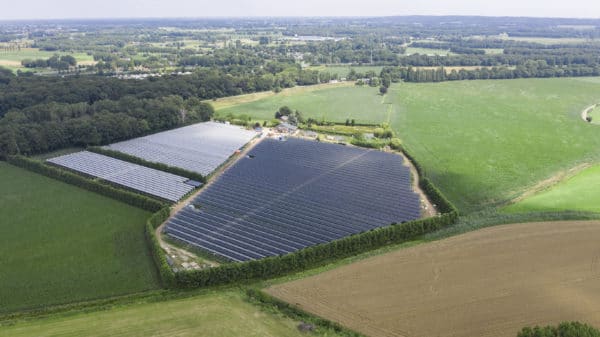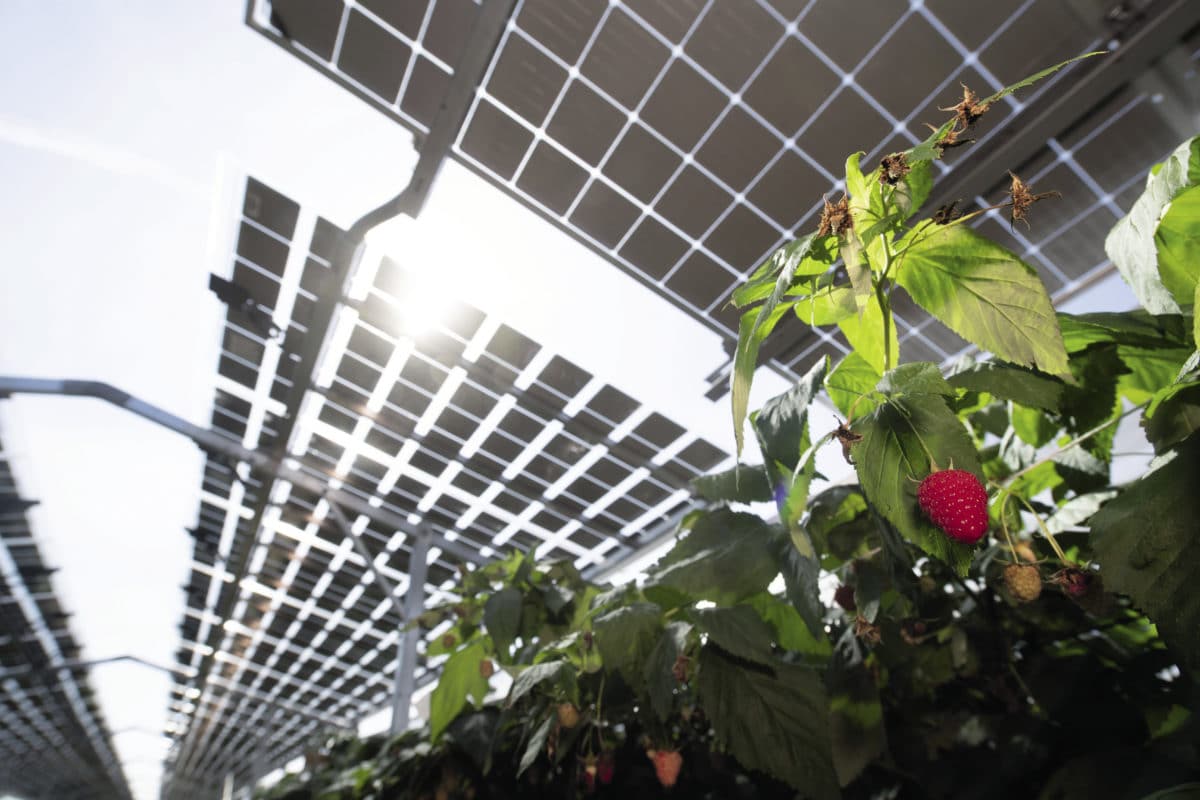Gone are the days when blueberries, raspberries, and boysenberries were a tasty snack reserved for diligent pickers browsing secret hunting grounds along forest edges. Indeed, for years, berries of all kinds have featured among the bestsellers for resourceful farmers. Planted in fields, they are available year-round in supermarkets, and their growth rates continue to rise.
But for these fruits to thrive they need the right balance of light and shade, which can be provided temporarily by netting and plastic sheeting, or permanently with agricultural photovoltaics (agrivoltaics). Piet Albers is a farmer from Babberich, in the Netherlands. He is trialing the latter method, having set aside a large area just for raspberries. He grows annual raspberry bushes that have been pre-planted in pots in a greenhouse. In his field, they then grow to height for three months and take around another six weeks from flower to harvest. The full season runs from April to September.
Since the spring of 2019, Albers has used the same land to produce solar power alongside the vitamin-rich snack fruits. Initially, he made 3,000 square meters of his field available for a BayWa r.e. pilot installation. In the middle of the raspberry rows, where posts once stood to support climbing stakes and a narrow roof of sheeting, the company erected steel girders, and above them a single row of sloping roofs comprised of PV panels. Since the rows of raspberries run north to south, the rows of modules point alternately east and west, and the climbing aids are now mounted to the supports of the solar roof.
Solar protection
The modules are specially made with gaps between cells that allow light to pass through. Stephan Schindele, the project manager at BayWa r.e., is tight-lipped about the exact ratio of light to shade. However, this is unsurprising, given that the optimum cell spacing is not easy to determine and can often only be established through extensive testing.
Satisfied with his raspberry harvest in the first year, Albers opted to expand the agrivoltaic installation to cover 3.3 hectares and has been very pleased with the results, reports Schindele. A wide gap at the peak of the sloping module roofs, which allows warm air to escape, has proven particularly beneficial. The raspberries are better ventilated than under the previous plastic film roofs, he says. And because the gaps are located between the rows of raspberries, they’re protected from direct sunlight, hail, and heavy rain at the same time.
Schindele cited measurements showing that on hot days, the temperature under the modules is five degrees lower than under the plastic sheeting and two degrees lower than in the surrounding area. At night, however, it was warmer under the modules than in the surrounding area. “Less temperature variation under the agri-PV encourages plant growth because less energy has to be put into temperature management,” Schindele explains. “At the same time, better airflow reduces fungal pressure, which decreases the need for fungicides.”
Although the solar experts and the farmer had originally expected lower yields, in the summer of 2020, the yields under the solar roofs were comparable to those under the plastic film. It turned out that somewhat slower growth was not a disadvantage, as it allowed more time for harvesting and selling.
Dual-use areas
The aim of agrivoltaics is to create dual-use areas for both agricultural purposes and power generation. If the math works out, land efficiency increases. Even if both sides of the equation produce less than they would on land used exclusively for one purpose, a higher overall economic yield is achieved.
In densely populated areas and on intensively used landscapes, such as those in Europe, the hope is that this will ease competition for land. In other countries, especially very dry ones, photovoltaics can help make agriculture possible on otherwise poorly suited land by protecting the soil from drying out and giving plants shelter from the scorching sun. For example, Greg Barron-Gafford from the University of Arizona, reported at a meeting last October that farmers in California are increasingly converting their fields to PV land due to water shortages.
Barron-Gafford’s studies on agrivoltaic systems have demonstrated that many crops photosynthesized significantly longer in the shade and produced more fruit than they would in the sun, where they stop photosynthesis shortly after noon to reduce water loss. Furthermore, under the modules, water does not evaporate as quickly. Since photosynthesis also removes carbon dioxide from the air, the combination of PV and agriculture has dual benefits for the climate.
In Germany, too, drought can increasingly pose problems for agriculture. Yet in these cases, the benefits often lie elsewhere. In projects like the one described, PV can replace other protection measures. Piet Albers’ employees, for instance, no longer have to go out into the field after storms to repair rain covers, and the PV panels are much less susceptible to storm damage. In addition, they do not have to be dismantled and stored for winter and they have eliminated the need to replace the sheeting, which becomes brittle in the sun and tears around every six years. Overall, solar is more sustainable as a permanent solution, and can save on labor costs.
BayWa r.e. strives to develop custom solutions, especially for crops that require additional protection by varying the size and spacing of the solar panels and their mounting system, explains Schindele. In parallel with the raspberry project in Babberich, the company is testing PV plants over blueberries, currants, strawberries, and boysenberries. Upcoming projects are also expected to include apple orchards and vineyards. Incidentally, in addition to climbing aids, rain gutters can also be fitted to the PV systems to enable the collection of heavy rain and its subsequent diversion back to the plants through an irrigation system.
Lower yield
Until February 2020, Schindele was the project manager for a German research facility in Heggelbach, Baden-Württemberg, which BayWa r.e. developed jointly with Fraunhofer Institute for Solar Energy Systems (ISE). The PV plant there is positioned very high, up to 8.5 meters, to allow machinery to pass underneath. Below the array, common crops such as wheat or potatoes are grown.
In an estimate of the costs of various agrivoltaic systems, Christoph Mayr, business manager of photovoltaic systems at the Austrian Institute of Technology (AIT), concluded that this variant requires the highest steel input. It thus incurs the highest installation costs of all the ground-mounted systems studied.
At the same time, the solar yield per hectare is comparatively low due to the large row spacing. Schindele and Max Trommsdorff, head of agrivoltaics research at Fraunhofer ISE, no longer see this experimental system as a gateway to agrivoltaics. Instead of interchangeable crops, the two are now focused on permanent crops.
On ordinary fields, on the other hand, Next2Sun and Solverde Bürgerkraftwerke Energiegenossenschaft’s systems – which are designed to allow agricultural cultivation between the rows of solar PV modules, rather than underneath them – seem to offer better value.
The Dutch raspberry PV plant is mounted at a much lower height than the plant in Heggelbach and covers the area more densely. It is installed on 3.3 hectares as a 2.65 MW array, which equates to 800 kW per hectare, compared to about 1,000 kW per hectare for a typical ground-mounted system in Germany.
This high capacity factor is mainly due to the east-west orientation of the array, which requires significantly smaller distances between rows. In an Agrivoltaics Guide published last October, Fraunhofer ISE indicates an average area coverage of 600 kWp per hectare for arable crops and 700 kWp for permanent crops, such as berries.
Without naming the specific costs, Schindele calculates an electricity price for PV plants in berry cultivation in the Netherlands of between €0.085 and €0.09/kWh. For pears, cherries or apples, the costs range from €0.09/kWh to €0.105/kWh.
The Fraunhofer guide is somewhat more optimistic, regarding average electricity production costs for permanent crops and grassland at €0.072/kWh. For cropland with higher and wider-spaced mounting systems, the costs come to €0.10/kWh.
Compared to smaller ground-mounted systems under 20 MWp, whose electricity generation cost Schindele estimates at €0.056 to €0.0795/kWh, the investment costs are higher, but at the same time, operation could be cheaper because there is no need for weed control and the cost of leasing the land may also be lower. The saved leasing costs and the potentially lower labor costs are not included in the comparison.
Overall, Schindele is convinced that it is impossible to finance a photovoltaic system through fruit growing alone, without a feed-in tariff or an adequate premium. Even Solverde Project Company, which develops agrivoltaic projects for power purchase agreements, considers them economically viable only at scales above 10 MW.

Image: BayWa r.e
| Assumptions for electricity production costs in agri-PV systems | ||||||
| Type of PV installation | ||||||
| Open space (smaller than 20 MWp) | Agri-PV (smaller than 5 MWp) | Rooftop installations (smaller than 10 kWp) | ||||
| Minimum | Maximum | Minimum | Maximum | Minimum | Maximum | |
| Investment sum (EUR/kWp) | 550 | 800 | 700 | 1100 | 750 | 1200 |
| Financing costs | 5% | 5% | 5% | 5% | 6% | 6% |
| Lifetime (years) | 25 | 25 | 25 | 25 | 25 | 25 |
| Operating costs (EUR/kWp/Jahr) | 10 | 14 | 9 | 16 | 12 | 18 |
| Income (kWh/kWp/Jahr) | 950 | 890 | 920 | 870 | 950 | 860 |
| Capital costs (EUR/Jahr) | 39 | 57 | 50 | 78 | 59 | 94 |
| Electricity generation costs (ct/kWh) | 5.16 | 7.95 | 6.38 | 10.81 | 7.44 | 13.01 |
| Source: Stephan Schindele, BayWa re, from a presentation at the Agrivoltaics Conference in 2020 | ||||||
If you compare the electricity generation costs in smaller agrivoltaic systems with those of ground-mounted and rooftop systems, it becomes clear that they are no higher than the conventional ways of producing solar power. Compared to ground-mounted PV, the costs seem high, especially when you consider that the investment costs are now lower than assumed here. In this comparison, however, the agricultural yield, which can be brought into the area at the same time, is not taken into account.
This content is protected by copyright and may not be reused. If you want to cooperate with us and would like to reuse some of our content, please contact: editors@pv-magazine.com.
